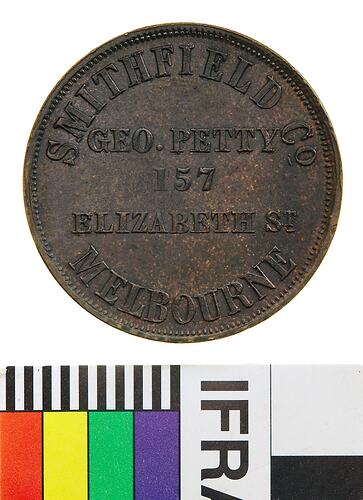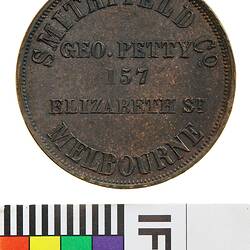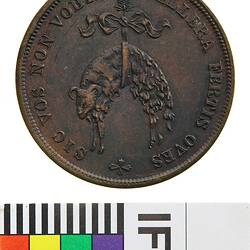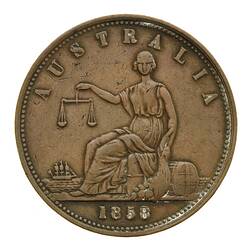Summary
Copper one Penny Token, late strike, minted by W.J.Taylor of London, circa 1880. This token is a late strike using Petty's obverse die with Dease's Reverse, it was probably made for collectors in the 1870s.
Petty is said to have arrived as a boy in Melbourne, coming as a sailor on a ship that brought settlers to Port Phillip. The first trace of him in Melbourne is working in a butcher's shop on Elizabeth Street in 1853. By 1854 he was listed as the owner of a butchery in Elizabeth Street, possibly the one he had been working at. He ran butcher shop at various city locations over the next fifteen years and was known as one of the best butchers in Melbourne. He died on 19 November 1877, leaving a widow, two sons and three daughters.
Dease was a wholesale and retail draper in Launceston. He issued token penny and halfpenny pieces, from his store 'The Golden Fleece' in 1855. Hall ran a grocery, coffee mill, wine and spirit outlet in Christchurch.
Previous Collections: National Gallery of Victoria
Physical Description
A round copper token (34 mm diameter) featuring the name, company name and address of the issues: Geo. Petty, Smithfield & Co., 157 Elizabeth Street Melbourne. The reverse features a Golden Fleece (as used on the token issues of E.F. Dease of Launceston Tasmania) with the Latin motto SIC VOS NON VOBIS VELLERA FERTIS OVES. This is a late strike using Petty's obverse die with Dease's Reverse. Probably made for collectors in the 1870s.
Obverse Description
Legend ion 5 lines: SMITHFIELD & Co. / GEO. PETTY / 157 / ELIZABETH ST / MELBOURNE
Reverse Description
Golden Fleece handing from ribbon off pineapple; around, SIC VOS NON VOBIS VELLERA FERTIS OVES +
Edge Description
Plain
More Information
-
Collecting Areas
-
Acquisition Information
Purchase from Max Stern & Co. Ltd, Nov 1976
-
Date Issued
circa 1880 AD
-
Issued By
George Petty, Smithfield & Co, Melbourne, Greater Melbourne, Victoria, Australia
-
Mint
W.J.Taylor, Mint, London, England, Great Britain, circa 1855
-
Person Named
George Petty, Smithfield & Co, Melbourne, Greater Melbourne, Victoria, Australia, circa 1855
This is a late strike using Petty's obverse die with Dease's Reverse. Probably made for collectors in the 1870s. -
Previous Collection
Numismatics Collection, National Gallery of Victoria (NGV), pre 1976
-
Inscriptions
Obverse: SMITHFIELD & Co. GEO. PETTY 157 ELIZABETH ST MELBOURNE Reverse: SIC VOS NON VOBIS VELLERA FERTIS OVES
-
Denomination
-
Series
-
Material
Copper
-
Axis
06
-
Classification
-
Category
-
Discipline
-
Type of item
-
Dimensions
35 mm (Outside Diameter), 15.104 g (Weight)
-
Shape
Round
-
References
Sharples JNAA.7 p.55 George Petty was a butcher who operated from a number of shops in Elizabeth Street, Melbourne. On the tokens his company is called Smithfield & Co. a name only in use in 1855-56. The token manufacturer was W.J. Taylor in London, named on the reverse. The issue of the tokens was probably from late 1855. See Sharples JNAA.7, p.54-5 (note the images of the reverse dies are reversed). There were two reverse die employed on the issue. The differences between the dies are in the relationship of the word VICTORIA to the position of the figure of Justice. On reverse 1 the end of the scale pan bar is 1 mm from the V and if extended would touch the base of the V, the head of Justice is almost fully below the O and the central support string of the scale pans is to the front of the pan. On reverse 2 the end of the scale pan bar is 0.6 mm from the V and if extended would pass just below the base of the V, the head of Justice is just to the left of the O and the central support string of the scale pans is to the back of the pan. The Petty dies were employed for late strikes by Taylor, perhaps from as early as 1870, but certailny by 1880. The late strikes are on lighter copper blanks, about 15 g while the original tokens are between 16.5 and 18 g. John Sharples November 2004.
[Book] Andrews, Arthur. 1921. Australasian Tokens and Coins.
[Book] Heyde, Gilbert C. & Skinner, Dion H. 1967. Unofficial Coins of Colonial Australia and New Zealand., No. 58
[Article] Sharples, John P. 1993. A Catalogue of the Trade Tokens of Victoria 1848 to 1862. Journal of the Numismatic Association of Australia. vol.7: p.1-77.
-
Keywords




